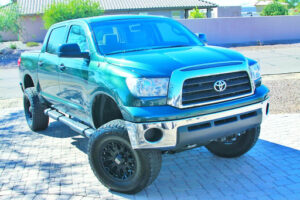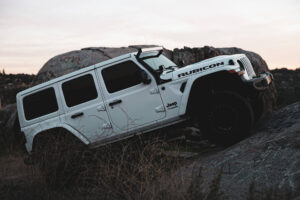If you want to improve your overall acceleration or if you just want to improve the control you have over your vehicle in low traction areas, the best way to do that might be just locking your rear differential.
If you did not know just how much locking your rear-end differential could do for your vehicle then you are probably going to be shocked with just how significant the action might have on your overall driving. There is also a bit of a misconception when it comes to driving in 4WD mode and driving with a locked rear differential.
One thing that we have to make clear is that the two are not the same and each comes with its own set of advantages and disadvantages. However, we are going to be touching on that a bit later on in this article.
Contents
The Working Principle Of the Rear Differential
The rear locking differential has the same principle function as both the center differential and the frontend differential.
The main difference that comes with the rear locking differential is the location as well as a bit of a twitch in the working principle.
The principal function of the rear differential is to ensure that both wheels when power is transmitted to them will rotate at the same speed without either of the wheels being stationary.
The rear locking differential is located on the rear axle. This is because the principal function of the rear locking differential like all the other forms of locking differential is to ensure that the wheels rotate at the same speed.
For the real locking differential, however, the main purpose is to perform the locking differential task but for the rear wheels.
In an open differential system, power is transmitted to the wheel with the least resistance. This means that the rear wheel that has the least traction will have the most power and as a result will be the one that moves.
The wheel that has the most resistance will have very little movement and in most cases will be stationary. This often results in a lot of problems and can make driving a living nightmare especially if you are driving off-road.
The rear locking differential in its way helps you to avoid the problems that come with the open differential.
We have already highlighted that the rear locking differential “locks” the rear wheels and ensures that at any point they are turning at the same speed. This means that wherever you are driving as long as the rear differential is locked, the rear wheels are going to be turning at the same speed and at no point will you have a stationary rear wheel.
We do not have to tell you how much of an advantage it is to have all rear wheels powering your vehicle when driving, especially when you are driving off-road.
When Should You Lock the Rear Differential?
We have already highlighted the working principle of the rear differential. As amazing as the mechanism and the changes that come because of using the mechanism, it does not mean that you have to keep the differential locked every time.
The main reason why engineers build the rear locking differential with “engage and disengage” capabilities is that there are some instances where it is not necessary to keep your rear locking differential locked.
The main scenario where it is completely necessary to lock your rear differential is when you are driving on an off-road surface. Locking your rear differential gives your vehicle more traction and overall better control.
Gravel, mud, and dirt are some Of the surfaces with the least traction and driving your vehicle on those surfaces can be somewhat of a nightmare if your rear locking differentials are not locked at. If you are driving on any of these surfaces then you must lock your rear differentials.
Most truck owners are quite keen to take their vehicles for rock crawling. On its rock crawling is quite dangerous, and going at it without locking your rear differential just adds to the danger.
Rock crawling then becomes another instance where it is necessary to lock your rear differential.
If you are using your vehicle for day-to-day driving on a paved or tarred road the chances are you are not going to need to use your rear locking differential often.
If however the roads become icy or are saturated with snow, you can always lock your rear differential. This is because snow or ice tends to reduce traction and to counter the loss in traction. Locking your rear differential is the best option you will have.
One thing that is very important to note when it comes to rear locking differential is that they can in a way tend to make taking turns quite difficult.
There is a bit of a misconception that tends to suggest that taking turns is a problem that is only associated with the frontend differential. Well, the rear-locking differential can result in the same problem tool.
As a cautionary measure try to mostly use the rear-locking differential when traveling on a road with minimal turns.
The use of the rear-locking differential is not limited to the situations mentioned here, if you are certain that you need a bit of a “traction boost” as you drive, be sure to lock your rear-locking differential.
The Advantages of Locking Your Rear Differential
There are several benefits that you are going to reap if you do decide to use the rear locking differential.
The best part is that regardless of your vehicle, you are still going to feel the positive effect of the rear locking differential if you use them right and in the right terrain and situation.
Here are some of the key advantages that come with using the rear locking differential.
Improved Traction
As we have already highlighted at the beginning of this article, the principle action of the rear locking differential is to help you drive in areas that are most likely going to result in low traction for your wheels.
If you have ever driven off-road then you will agree with me that even if your engine is the most powerful, if there is only one rear wheel that is rotating, it is going to be very difficult to get out of mud or snow.
This is because of the low traction. The rear-locking differential ensures that all rear wheels are rotating at the same speed. This means that you are assured that the full power of your vehicle is equally distributed between the wheels.
This is very important especially when it comes to rock climbing when one wheel can be free hanging. If you do not have a rear-locking differential in an instance like that, chances are the freely hanging wheel will be the only rotating wheel.
The scenario is different with a rear-locking differential as both wheels will be spinning and not the wheel will be stationary. This means that you will have all the traction that you can get regardless of the terrain you are maneuvering.
Even Power Distribution between the Rear Wheels
One thing about the rear locking differential is that when activated, all the power that is being delivered to the rear end of the vehicle will be shared evenly between the rear wheels.
This means that in most instances the workload will also be shared evenly between the rear wheels. This will help you avoid a situation where only one rear wheel is dealing with the tough terrain all the time.
The problems with a scenario like this are quite numerous and the best way to avoid them is by using the rear differential lock.
Improved Off-Road Experience
Well, we cannot stress this enough. The tow that driving off-road has on both the driver and your vehicle is quite immense and as a result, you are going to need all the resources you can have.
One thing that the rear-locking differential does is make the off-road driving experience bearable. This is because with the rear locking differential-locked you are not going to have to worry about your low traction environments.
If you are going to be driving in rocky areas, the rear-locking differential will help ensure that the drive is nothing but just a breeze.
Ease Of Use
One of the other reasons why the rear-locking differential tends to stand out is the fact that it is quite easy to use.
The mechanism in most modern vehicles can be switched on by a click of a button and in other advanced vehicles, the rear-locking differential is locked or unlocked automatically depending on the terrain that you are driving on.
This means that even for drivers that have no idea what a rear locking differential is, using it will just take a little bit of guidance and they are off to a fly.
The best part is that the rear locking differential once activated has a very little negative effect on your driving. The fact that it tends to make taking turns difficult is minimal and can be quite negligible.
Is A Locked Differential Similar to 4WD?
The main contest is usually between AWD and 4WD but off late rear locking differentials have been part of the 4WD conversation.
Both the rear locking differential and the 4WD system are designed to effectively improve the driving experience. There are several similarities between the two but there is quite a significant difference in terms of the working principle.
For the 4WD, the main thrust is on power distribution. Power is transferred from the engine to a transfer case and then distributed equally to the front and rear axle.
This is where 4WD ends and then if the car has a rear locking differential the rear locking differential will ensure that power is distributed equally between the rear wheels.
Differences between 4WD and Rear Locking Differential
| 4WD | Rear Locking Differential |
| Two differential system | Single differential system |
| Always has a transfer case | Does not require the use of a transfer case |
| Deals with both rear and front end wheels | Deals with only rear wheels |
Conclusion
One thing that is important to note is that although the rear locking differential improves your vehicle’s traction and your overall driving experience, it is not a license to over speed and try to maneuver through dangerous terrains.
If you use your rear locking differential the correct way, we can guarantee you that your whole driving experience will change for the better and you will certainly enjoy off-road driving as you have never done before.
Just be sure to avoid locking your rear differential when it is not necessary. That way you will avoid extra maintenance costs.
Enjoy off-road driving as you have never done before with the rear locking differential!



